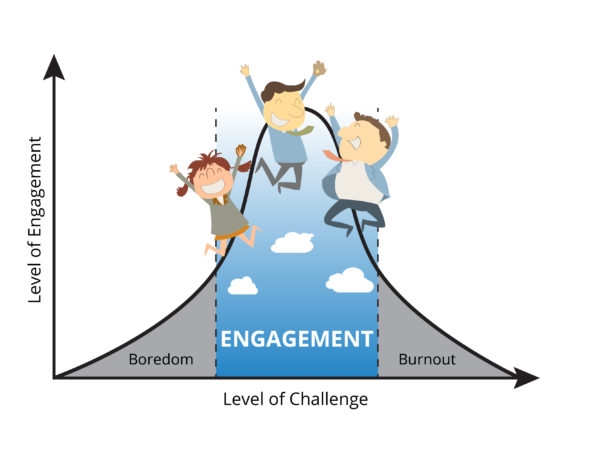— August 10, 2017
One of the biggest reasons people leave jobs is to seek opportunities for growth.
According to Glassdoor, job seekers ask about growth opportunities more than any other benefit. They also found that career growth was the top reason people leave their jobs. An employee’s perception of his or her own personal and professional growth is also one of the top predictors of engagement. When employees stagnate in their progress, they tend to be less engaged, and they look for other opportunities. Average tenure at most organizations gets smaller all the time. Your employees often believe their best opportunities reside outside the organization. Employees need skills and experiences to qualify for those opportunities.
Many managers and organizations might look at this problem and throw their hands up. They do not want to add levels of management to their organizations to provide more growth opportunities. In fact, many organizations are trying to flatten rather than deepen their management structures.
Managers can help with this problem by opening a dialogue with their employees about growth. Many managers either consciously or subconsciously avoid conversations about career progression when they don’t have a promotion to dangle in front of their employees. They lack a narrative for growth outside traditional promotion opportunities. Below are five growth conversations that every manager should have to engage their employees.
Conversation #1: Career Ambitions
Managers should have a pretty clear understanding of the direction each of their employees want to take their careers. All other growth conversations stem from this one. This should be one of the first conversations a manager has with his or her employees. Managers should first gauge how important career development is to their employees. Trying to push an employee into growth who does not want growth can be counterproductive.
The initial role of a manager in this conversation is to listen for understanding. Managers should be able to understand and clearly articulate the career ambitions of each of their employees. Managers should return to this conversation regularly to demonstrate their deep knowledge of their employees’ ambitions and to check for changes in their plans. The very act of listening and understanding will cause employees to feel that their managers care about their careers. This alone—without further action—can cause people to feel better about their career prospects.
A manager can also serve as a mentor in these conversations. If an employee does not have a clear picture of his future, a manager can help him in painting that picture. Managers can draw on their own experiences and the experiences of others to help employees define their futures. When employees have a vision of what they can become, it becomes easier for them to deal with less exciting parts of their jobs.
Conversation #2: Strategic Goal Setting
Through the career-ambition conversation managers understand the long-term goals of their employees. Managers should also help create a short-term plan to build toward long-term ambitions; this is done in the strategic-goal-setting conversation.
Most managers have an annual goal-setting session with their employees. These sessions are typically associated with an annual review process, and they typically revolve around tactical goals that address performance in an employee’s current position. The strategic-goal-setting conversation should be decoupled from the tactical-goal conversation. Employees should know the conversation is being had to specifically address their career ambitions. During the conversation, the manager should gain understanding about the competencies, skills, and experiences the employee needs to ultimately achieve his or her long-term ambitions. The conversation is future oriented, but it focuses on what we can do now. Together the employee and the manager figure out what skills can be learned over the short term that are both applicable to the employee’s future direction, and applicable to what the organization is trying to accomplish.
Sometimes an employees’ skills and competencies do not align with direction of the company. In this case, the company needs to decide if they are willing to invest in growth for the sake of growth. The best short-term goals build skills and competencies that are both strategic for the employee and for the organization.
Conversation #3: Opportunity Alignment
Depending on the employee, some job tasks that need to be completed may be viewed as an opportunity or as an obligation. Some of that perception will be guided by an employee’s vision for his or her future. Of course, we recognize some tasks assigned by a manager may be viewed as attractive by every member of his or her team. Some tasks are universally undesirable. Somewhere in between the extremes of that spectrum are tasks that are attractive to some but not others.
The alignment conversation is a regular check-in to understand what tasks have emerged that the employee finds attractive. Managers who know the goals of their employees are better able to present tasks or responsibilities to their employees who will view them as attractive. Aligning tasks to those who view them as attractive may mean sacrificing efficiency in the short term. Managers will often find it easier to assign tasks to their subject matter experts. The increased engagement your team experiences from variety and new challenges will counterbalance any loss in efficiency.
Conversation #4: Framing
Even if you have perfectly aligned your team to the tasks each member finds to be attractive growth opportunities, you will likely find you have a tremendous number of remaining tasks that nobody finds attractive.
The term “framing” is used in psychology to describe a bias that occurs when people make different choices depending on how the choice is presented to them. Even when faced with identical facts, people make different choices when those facts are presented with a positive frame versus when those facts are presented with a negative frame.
Employees taking on challenges need positive framing. Without framing, some of the benefit of the challenge is lost. People still grow, they just don’t view the growth as positive. I am not advocating manipulation of employees. As a manager, it is important to see the real benefits of the challenging assignments employees are taking on. Managers should understand and articulate for employees not only how the challenge benefits them in their current positions, but also how it will benefit them in their future endeavors.
Conversation #5: Temperature Check
Providing growth opportunities to employees is about creating engagement. Growth opportunities get employees out of the day-to-day boredom of their jobs. If a task is not providing the challenge it is intended to provide, think about adding additional challenge to the task. Push them to achieve better results; remove some of the support structure; add complexity with corresponding tasks or responsibilities; add a leadership component. Do something to the task or responsibility to raise the level of challenge.
On the flip side, some employees dealing with a new task or responsibility may begin to feel overwhelmed. In this situation, a key benefit of growth is lost. Overwhelmed employees find it difficult to engage over the long term. Throwing a person who cannot swim into the deep end of the pool without a life preserver is more likely to drown them than to teach them to swim. Likewise, an employee who is given a task that he has very limited ability to accomplish on his own will lead that employee to burn out rather than engage. In these situations, a manager should apply additional training, guidance, support, and resources to help the employee.

There is a space between boredom and burnout where engagement occurs. The temperature check is a conversation to be held frequently to understand where the employee is between boredom and burnout and to adjust accordingly.
Frequency
The frequency with which these conversations need to occur depends on the employee. Some employees have extremely dynamic ambitions—they change their minds all the time. With these employees, you may need to have regular conversations about career ambitions. For most employees, you can get away with having the ambition conversation only once a year. The alignment, framing, and temperature-check conversations should all be happening as challenges arise and as employees complete growth opportunities.
Should I Stay or Should I Go?
Many organizations may see this as a catch 22. If they don’t invest time and resources into growing their employees, their employees leave to find growth opportunities elsewhere. If they do invest time and resources into growing their employees, their employees use their new skills and abilities to find new jobs.
Let’s look at both scenarios. In the first scenario, an employee feels like he or she is no longer growing. The employee becomes bored with the day-to-day tasks he or she fulfills. The employee disengages. The employee leaves the organization for a new opportunity. The employee’s exit is probably viewed as a positive thing, because that employee was disengaged anyway.
In the second scenario, the employee feels like he or she is no longer growing. The manager finds out about the employee’s career ambitions. The manager assigns existing tasks in the organization to the employee based on interests and growth plans. The manager offers ongoing support to the employee to ensure he has the resources and training he needs to complete the new or novel task. The employee remains engaged. The employee, equipped with new skills, may look for a new job outside the organization. The employee may also see the merit in being part of an organization where he has the opportunity to gain new experience and build skills. The employee may stay; but even if your attitude is that employees are going to leave the organization either way, you may as well engage them while they’re here by helping them grow!
Business & Finance Articles on Business 2 Community
(138)








